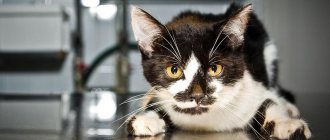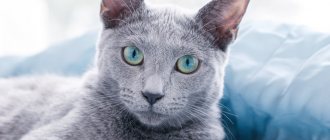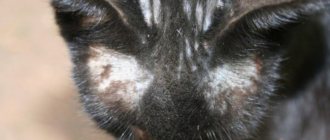Where does a cat secrete sweat?
The sweating system is extremely important as it helps improve heat exchange and prevent the body from overheating. Domestic furry predators are distinguished by such a feature that they have very few sweat glands.
Cat's reaction to heat
So do cats sweat? Sweat glands in cats are located only between the toes, in the area of the lips, cheeks, around the nipples and anus. In this, cats are similar to dogs. Therefore, a healthy animal produces very little sweat and only in the above-mentioned parts of the body. This is how cats sweat. In the summer, you can notice rashes from wet paws - this is the release of sweat from the pads.
Interesting! Cats have two types of glands: eccrine and apocrine. The first type includes the glands located on the paws, and the second type includes the rest.
Pets are able to secrete sweat not only in hot weather, but also when nervous. A person also has this characteristic - his palms begin to sweat at the moment of any emotional stress.
Endoparasites
If you notice your pet constantly wanting to scratch a bare area, this may indicate the presence of endoparasites. For example, scratching with teeth or claws may occur in an animal due to unpleasant flea bites. In order to relieve the animal from unpleasant sensations, special solutions, sprays and drops for the withers are used. Treatment must be carried out several times in order to remove not only adult individuals from the fur, but also newly hatched larvae.
Of all the internal organs, the intestines are the most susceptible to parasite penetration. Antihelmintic drugs are excellent for removing worms from the body. However, if the case is advanced (for example, when infected with large worms), the cat may need surgical intervention.
You might be interested in: Why does a cat have bad breath: causes and treatment
Ear mites can be treated with drops and proper care for your pet. You will need to remove him from contact with stray animals and prohibit him from eating rodents and wild birds.
How do cats cool down?
If the sweating system helps cool the body, then how do cats, which have so few corresponding glands, escape from overheating? Due to the thick fur, the released liquid evaporates without cooling the animal's body.
Do dogs sweat: do they have sweat glands?
An interesting fact is that the glands secrete sweat not to allow the skin and body to cool, but for odor marking. With the help of secretions (sweat), cats mark their territory. Even when they sharpen their claws on furniture, they can secrete a secretion for the same reason. Therefore, it is not sweat that helps pets cool themselves, but other methods:
- Licking. When washing, the cat begins to cover its fur with saliva, thereby the liquid evaporates and cools the body. An animal's saliva consists of water, salts and enzymes. The salty liquid evaporates quickly, which helps lower body temperature. Also, with a large amount of saliva, the cat begins to experience a salt deficiency, which means that the body begins to produce heat more slowly.
- Decreased activity. To cool down, the cat begins to move a little or sleep a lot. This way the temperature remains at the same level.
- Body position. The cat stretches, looks for shade - this helps to cool the body from the outside.
- Drink. In hot weather, animals begin to drink more water, which promotes the secretion of saliva, thins the blood and restores water balance in the body.
- Wool. It is believed that keeping the fur close to the cat's body helps it cool down. And when it is fluffed, the body is warmed, since the air between the hairs retains heat inside.
Important! Kittens have imperfect thermoregulation, so they quickly freeze or warm up. The kitten cannot help itself to warm up or cool down, so it needs help to overcome the discomfort. In nature, the mother is responsible for this - she licks the cubs and warms them.
The cat curls up into a ball from the cold
Hot city: summer for cats
How do pets cope with heat? When temperatures start to rise, your cat may be more comfortable than you think. According to The Washington Post, the average body temperature of cats is about 39 degrees Celsius. In addition, since their ancestors originally lived in the desert, they learned to obtain most of the necessary moisture from food.
However, this does not mean that the animal will be safe and comfortable locked up in a warm home. Do cats sweat? Yes, but much, much less than people. Instead, your furry pet needs to passively provide heat at all times. To do this, she lies on cool surfaces, breathes frequently, drinks cool water, and licks herself frequently.
Make sure your cat is comfortable. To do this you need to do a few simple things:
- Water is everywhere. Since water evaporates faster in the summer and your cat may be inclined to wander around the house, we recommend placing several bowls of cool water throughout the apartment. If your house has several floors, there should be bowls of water on each floor. Place them under a chair or away from sunlight and cat food to make them look more attractive. You can even put empty bowls in the freezer overnight and fill them in the morning to keep the water cooler longer.
- Homemade ice pack. Place a homemade ice pack where your pet likes to rest. If she gets too hot, a frozen water bottle wrapped in a towel can make a nice naptime cuddle buddy (remember to put it back in the freezer when you get home). Never leave your cat alone with commercially available ice packs, as the chemicals they contain can be dangerous if they burst or leak.
- Close the curtains. By darkening a few rooms, you will limit the amount of sunlight and heat entering your home. Your cat will be grateful for the shade, and you won't feel stuffy when you return in the evening.
- Leave the fan on. One or two small fans in the right places will circulate air and keep your pet relatively cool. You can use a timer for your fan if you don't want it to run all day.
- Give her a cool refuge. Animals love to chill under furniture, so you can use stands to make your bed higher so that your cat has enough space to sleep and rest comfortably. Plus, covering your kitchen table with a tablecloth can make a great hideaway for your pet underneath with a cool tile or wood floor.
How to tell if a cat is hot or cold
Mammary cancer in a cat: breast tumor
Some symptoms can easily determine whether a cat is cold or, on the contrary, very hot.
When a pet is cold, it:
- curls up into a ball;
- hides nose;
- sits ruffled;
- demands to eat more often;
- trying to move more.
When a cat is hot, it:
- lies stretched out;
- looking for shade;
- licks himself a lot;
- drinks water often.
The owner of the cat should help her in every possible way: do not forget to pour water into the bowl during the hot season and not force her to move a lot.
How to prevent overheating in cats
In very hot weather, cats may experience overheating. This can have a detrimental effect on the animal’s health, so the owner needs to monitor the pet’s behavior and try to prevent such a problem.
How many nipples does a cat have? Do cats have them?
Signs of a cat overheating:
- breathing with an open mouth and raised tongue;
- deep, sharp and abrupt sighs;
- wetness of paw pads;
- weakness;
- lack of appetite;
- cardiopalmus.
Having your cat breathe with its mouth open helps it breathe in moist, cooler air. Thus, the walls of the nasopharynx and lungs cool faster, and body temperature decreases.
Note! It should be understood that sometimes breathing with your mouth open is a warning sign. It is necessary to monitor the cat’s condition, as there is such a thing as “heatstroke”. The owner must correctly interpret the symptoms and provide emergency assistance.
How to recognize that a cat has heatstroke? This is indicated by an elevated temperature, which the cat is unable to reduce on its own or from the outside. The norm is 38-39 °C, and for kittens – up to 39.5 °C. At elevated body temperatures, blood becomes thicker and circulates poorly throughout the body, which leads to the accumulation of toxins and even stroke.
Important! Breathing with your mouth open is not always a sign of heatstroke. A cat can breathe through its nose but still need help.
Sticking out tongue is a sign of overheating
After measuring the temperature (rectally) and confirming that it is not normal, you should first:
- Give your pet water, and if he refuses, then force it.
- Moisten the cat's fur with water.
- Apply a cool (not cold!) towel to your ears. The skin on the ears is thin, so cooling occurs faster.
- Gently dip the cat's body into a bowl of water at room temperature. Never in the cold - this can provoke an attack!
If after this the animal does not feel better within 10 minutes, then immediate medical intervention is necessary.
When to contact him immediately:
- the cat breathes with its mouth open and there is a blue discoloration of the mucous membranes - evidence of heart failure;
- redness of the tongue and gums;
- the pet’s loss of orientation in space, lost gaze, too dilated or constricted pupils;
- weak, slow pulse;
- short sighs, weak and slow breathing - an attack of respiratory failure;
- vomiting, excessive salivation, mucus discharge from the nose;
- unpleasant odor from the mouth;
- convulsions;
- dyspnea;
- lack of response to external stimuli;
- coma (in rare cases).
Additional Information! Pets with short and flat faces, such as Persians, kittens, pregnant or older cats, are more susceptible to overheating.
You should not allow the animal to be in direct sunlight for a long time; you need to monitor its body temperature, behavior and the availability of fresh drinking water. During the hot season, you should ventilate your apartment or house more often. You should never leave an animal without air in an enclosed space, such as a car.
Other methods of self-cooling
The cat itself feels that it may overheat and uses various tricks to improve its well-being. For example:
- Moves little, seeks shade or lies on the cool floor somewhere in the bathroom. All of these methods help slow down your metabolism and reduce heat production.
- Drinks a lot. The body produces more saliva, which is then used for licking.
- Fans himself with his tail. This movement activates the sweat glands around the anus.
- Breathes with an open mouth. The animal resorts to this method in exceptional cases, when it is almost on the verge of heat stroke. In this case, the tongue will be tense, slightly raised upward, and the breaths themselves will be taken very sharply and impetuously. Breathing in this rhythm quickly cools the nasopharynx and lungs, the blood vessels dilate, the blood moves faster, and the body temperature drops.
Important: mouth breathing is a bad sign, signaling that the animal is completely overheated. It is necessary to immediately provide the cat with the necessary assistance.
Some advice for cat owners
The owner of a fluffy beauty should always monitor her health. Do cats sweat, regardless of the temperature indoors or outdoors? Even though cats have few sweat glands, they can sweat profusely. What this is connected with is described below.
Disease
If the owner notices that the cat’s fur has become greasy, the body temperature is increased, it leaves wet paw marks, but there could be no overheating, then he should consult a doctor, as this is a clear sign of the following pet diseases:
- infection;
- AIDS;
- leukemia;
- flu;
- panleukopenia (“plague”).
If treatment is not started in time, death will be guaranteed. There are other signs of these diseases, sweating is just one of them.
The animal's greasy fur is caused by excessive sweating.
Stress
Many factors can trigger stress in a cat, causing it to sweat profusely. Irritation of the nervous system can cause:
- physical damage;
- poisoning;
- avitaminosis;
- hunger;
- emotional disorder (moving, lack of attention, etc.).
Overheat
You should always keep an eye on your cat during the hot season, especially long-haired breeds. The owner should comb the coat more often, or cut it completely in the summer. Cats should also be allowed into cool places, such as the bathroom tiles.
Why do wet bald spots appear?
One of the common reasons for the appearance of one or more bald spots in a cat is injury. Representatives of the species are known for restlessness and activity, especially during the mating period, when each individual defends its own territory. If the pet simply ran into a stronger opponent and lost a tuft of hair, the spot will not itch and will quickly heal.
You might be interested in: How to remove fleas from a cat: quickly and effectively, review of products
However, another development of events is also possible. You may notice a wet, bald spot on your cat, which would be classified as a bite wound. Such a bald spot does not heal for a long time, and the ichor and necrotic exudate oozing from it resemble rotting meat in smell and color. There may be several reasons for the appearance of a wet spot:
- Burns caused by prolonged exposure of the fur to sunlight;
- Thermal burns due to open flame, steam or electric current;
- Chemical burns;
- Problems with local blood circulation associated with diseases of the cardiovascular system, thrombosis, the presence of parasites in the body, etc.;
- Eczema, dermatitis (atopic or allergic) and other skin ailments, including fungal ones;
- Prolonged mechanical irritation. For example, a wet bald spot on a cat’s neck may appear due to an incorrectly selected flea collar;
- Transformation of an ordinary abrasion into a weeping wound, which turned out to be infected with pathogenic microflora;
Important! In order to determine whether the healing process of a bare spot is natural or proceeds with complications, resort to the help of your main “allies” - smell and visual inspection. If the stain shows discharge of pus and a cloudy substance, and it smells extremely unpleasant, you should consult a specialist. Owners of long-haired beauties should be on guard, because bald spots in their thick fur can be noticed too late.
Do Sphynx cats sweat?
What to do if the cat has no hair at all? The Sphynx cat differs from other felines in the absence of fur on the body, and therefore thermoregulation. But this does not mean that the Sphynx is not susceptible to heat stroke.
Their peculiarity is that they sweat throughout their entire body, rather than in just a few areas. Since these cats do not have fur, they are not protected from temperature changes like other breeds. But sphinxes are not completely defenseless. Nature has made the body temperature of hairless cats 1 degree higher than that of woolen pets. Accordingly, the sweat glands cool the Sphinx more actively to prevent heat stroke.
All this leads to the fact that such cats get dirty faster and leave dirty marks on the furniture. The more the Sphynx sweats, the dirtier it becomes. It depends on his state of health or emotional stress. Therefore, such cats should be washed or wiped with a damp cloth more often, otherwise the accumulation of large amounts of fat and sweat on the animal’s body can provoke the appearance of bacteria and skin diseases.
Sphinx
You need to monitor your pet's health. If your cat is sweating profusely, you should immediately consult a doctor. It is always necessary to monitor the cat’s nutrition and the temperature in the room so that the animal feels comfortable.










